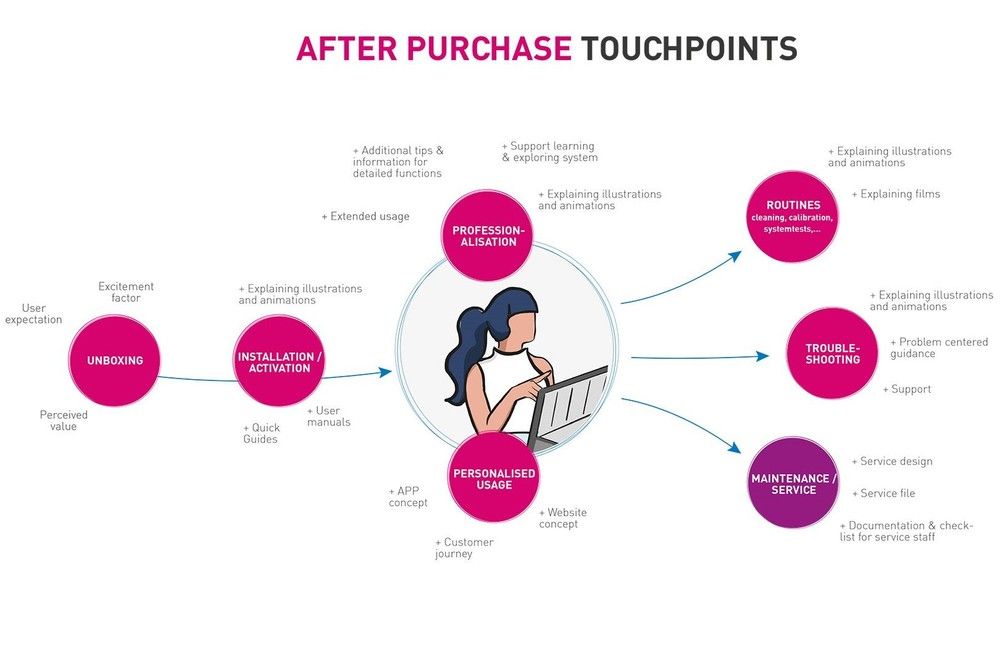Product success on the market is not generated by often comparable technical parameters, but largely by user enthusiasm. It is not only the user experience that counts, but also the touchpoints before the purchase, during unboxing and installation as well as throughout the entire life cycle and in service situations. By considering all of these user touchpoints, all of the potential on and around the product can be exploited and not only user-friendly but also inspiring products can be developed. Digital options for providing the right information at the right time play a major role here.
One of the biggest influencing factors for product success is the user experience. This can be achieved through iterative development loops and user testing, where the end user is involved in development at an early stage. We have already discussed which external influences actually make products successful. However, in order to turn the user experience into genuine enthusiasm, i.e. a high level of user excitement, and thus generate strong competitive advantages and differentiation opportunities, it is necessary to consider all user touchpoints holistically:
The levels of user excitement
At BUSSE, we have set ourselves the goal of developing products with our customers that excite the user! To achieve this, we work with our customers to think beyond traditional methods such as the human-centered design process and take a holistic view of a product's interfaces:
- The experience with the product before purchase
- The product experience during unpacking and initial installation
- The product experience during the further course of use:
This includes aspects such as optimal support for routine maintenance/updates, the facilitation and experience of individualization and the development of a more extensive range of functions and the provision of this information.
The first level comprises the touchpoints of a potential user before purchasing a product. It is important to reflect on the ways in which they come into contact with a product and how you can inspire potential users even before they actually buy it. From our point of view, there are many more possibilities here than well-designed advertising campaigns and product photos: There are already unboxing experience videos for many products on YouTube and other channels, for example, but these are created independently by third parties. These and other content in particular should be actively generated by the companies themselves and used with inspiring product animations to make the products tangible before the purchase. In addition, possibilities such as digital showrooms should be used in which the products can be displayed and configured in three dimensions using AR / VR features, for example, and placed in the future environment. Online stores should also offer well thought-out user and information guidance with product configurators that anticipate as much as possible. Informative product displays, brand-defining shop-in-shop systems and high-quality packaging are important for presentation in real salesrooms.
If the potential user decides to buy, the second stage of unboxing and commissioning should exceed expectations as far as possible and spark enthusiasm to the full. Small details such as intelligently designed and frustration-free packaging and intuitive support for the customer during installation and commissioning are important here. No user wants to work through thick operating instructions and poorly presented assembly instructions. Condensed quick guides and smart assembly concepts as well as clearly understandable icons and product markings are what count here. This information no longer necessarily has to be available only as printouts - digital step-by-step tutorials can also provide support here. You should therefore ask yourself the question: what does my user expect, where might he have problems and how can I support him on which media?
During the usage cycle, enthusiasm must be maintained for as long as possible. In our view, not all potential is being exploited here either.
On the one hand, the user may want to get to know the product more extensively and learn additional functions that he is not familiar with and/or adapt them to his specific user behavior. There are exciting possibilities here that go beyond the current "Did you know" wipe menus and the "Karl Klammer" of Office products, which we found very annoying at the time.
Especially in routine maintenance situations or when troubleshooting, there is explosive fuel that can quickly turn initial product enthusiasm into the opposite. A well-prepared manual for recognizing and rectifying faults and instructions for service work is not rocket science. Current copiers and printers demonstrate this very impressively: Whereas a few years ago, users would leave as unnoticed as possible when the copier reported a toner change or paper jam, nowadays the existing display is used to guide the user through the process step by step in a clear graphic format.
Hardly any end user has the printed operating instructions to hand after 2 years of use and the first service and problem case.
Simple problems or maintenance tasks could be guided by explanatory illustrations, animations or films on the device itself. This can be used very well for products without their own display, for example, via digitally stored guides and/or accompanying apps. Additional customer loyalty and after-sales revenue can also be generated with service components.
Troubleshooting can be covered by a proper service concept such as problem-oriented question catalogs or easily accessible support. If a service technician is required, he can also be supported by good product features and thus reduce his processing time.
As experts in holistic product development with a strong user focus, we see it as our task to subject all products developed and designed with us to this requirement. However, simply looking at the product alone is not enough.
If you are also interested in a holistic user experience, please contact us. We will be happy to advise you and show you the possibilities for your project.









